There’s a frequently quoted trope about Iceland which says that if you don’t like the current weather conditions, wait ten minutes and something completely different will come along. Translocate this a few thousand kilometres south-east to the Mediterranean island of Sardinia and it could accurately be applied to the variety of gravel trails you will encounter there. In the course of a week’s riding there with cycling holiday company Saddle Skedaddle, Olly discovered that the types of trails that you will encounter will change so often you will lose count. But a visit to Sardinia is about so much more than just the (amazing) trail network.
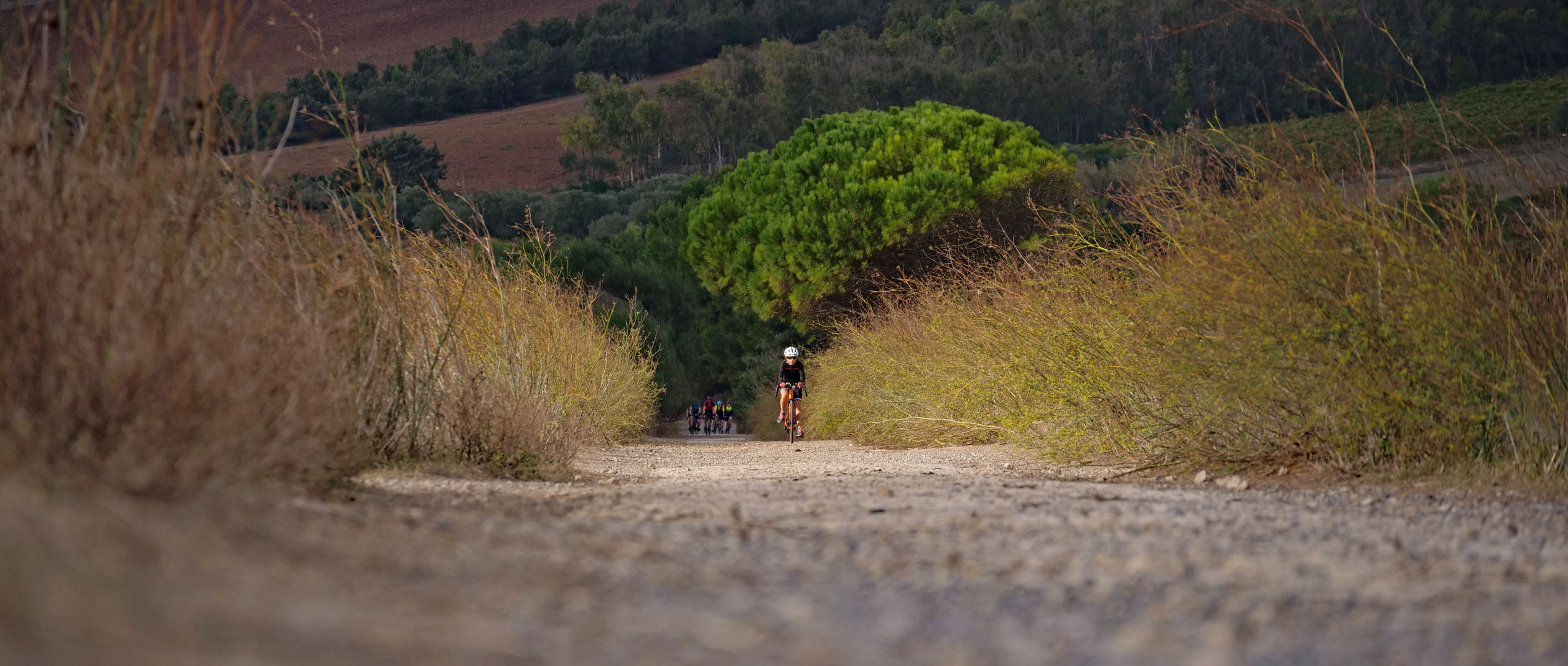
“What are they farming here, stones?” said Doug with a deadpan tone to his voice. We had stopped to regroup at the intersection between our gravel 4x4 track and a small road. Directly opposite us was a small traditionally built stone farmhouse, located on a small plot halfway up a gently sloping hillside. The hillside was essentially barren. There were a few gnarled olive trees, some low scrubby bushes and that was it. The ground was a pale brown colour. There wasn’t a blade of grass, or any other greenery, anywhere in sight. The farmers who lived and worked there appeared to have been collecting stones, presumably for a future drystone wall construction. The stones had been neatly gathered in two small mounds. To all intents and purposes, it looked as though they were farming stones.
When the whole of northern Europe appears to have had one of the wettest summers on record, coming to join a weeklong gravel riding holiday in Sardinia at the tail end of September was like being beamed down to a different world entirely. The lack of rainfall and the aridness in some parts of the Sardinian landscape is quite understandably a big source of worry to many Sardinians, but from the entirely self-centred viewpoint of a group of enthusiastic gravel riders, we were in heaven. The forecast was for unbroken sunshine for the first three days. The bikes needed washing after the second day because the layer of dust on them had grown thick to the point of slovenliness. Everyone was getting through litre after litre of water during our rides. We all had the kind of rosy-cheeked holiday glow that only comes from spending time in the outdoors, in perfect weather, doing something we love. In short, it was perfect.
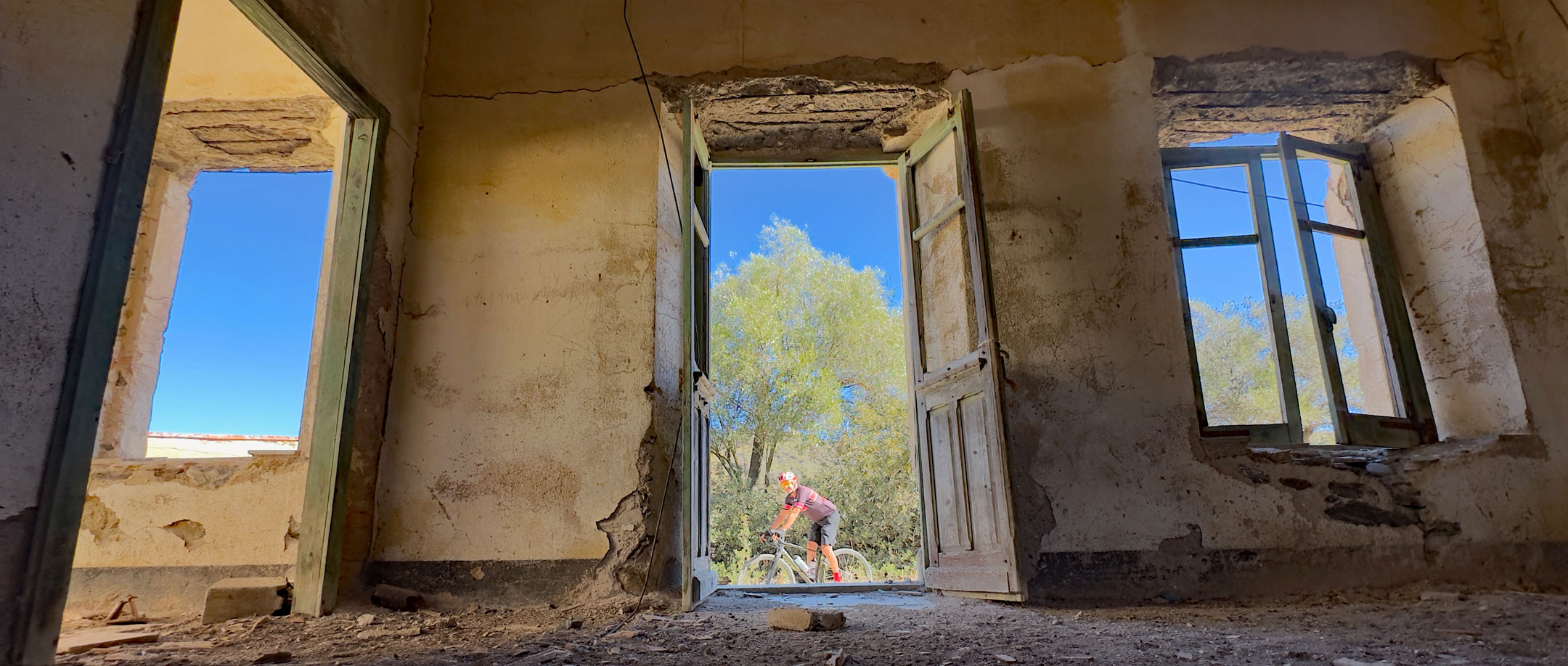
Of course, although we were all chuffed to bits to have managed to find the perfect way to eke out summer for one more week, the impact on the landscape and the people on the part of the island that we rode through for the first few days of our tour was clear to see. On day two, we rode through the middle of an abandoned village. Pathos seemed to emanate from between every stone of the once loved houses that lined the small central street. The lack of water eventually forced the residents to move away and the buildings have been left to slowly crumble back into the landscape.
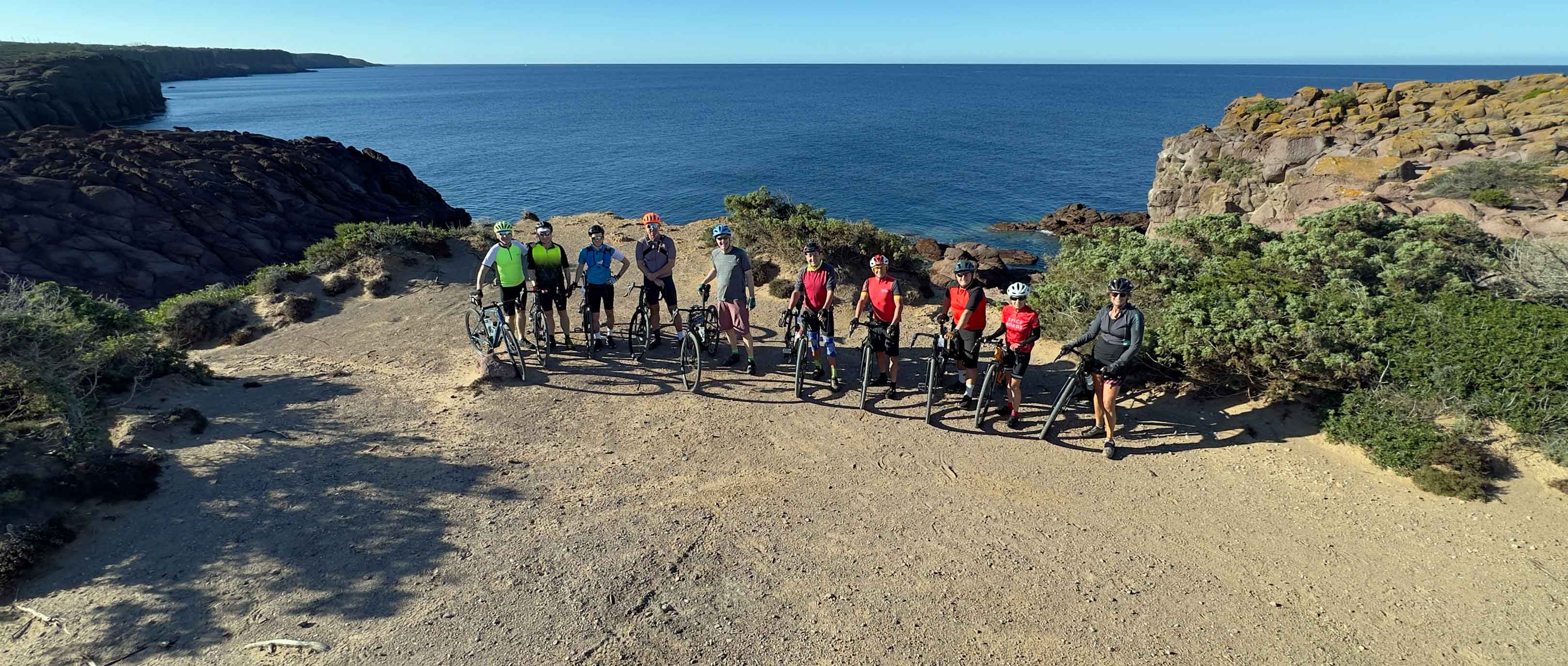
The island of Sardinia, like the Skedaddle group for the week, is incredibly diverse. Sardinia has often been described as a “micro-continent” because there is such spectacular variety crammed into its relatively diminutive size. The island has a varied geomorphology with hills, mountains, upland plains, coastal plains, wide river valleys, vast areas of saltwater lagoons, spectacular rocky coastlines and wide sandy beaches. Wildlife which can be found includes everything from the spur-thighed tortoise to the griffon vulture to the ubiquitous Sardinian sheep. Our group of ten riders was equally as varied and included a mix of ages, genders, couples, siblings, a father-son team, some singletons and a random cycling journalist from Newcastle upon Tyne, whose job it was to try and integrate into the group and then give the cycling world a customer’s perspective of a gravel riding trip.
Day One – In at the deep end
The first day of riding was genuinely my favourite ever day on a gravel bike. Having been fortunate enough to have ridden hundreds of ‘gravel days’ in destinations all over the world, that is not a statement that I make lightly. However, it was a hard start to the week and it would be fair to say that as we arrived at our hotel at the end of Day One having ridden just over 80 km, the majority of the group were completely cooked and were definitely not all quite as enthusiastic about what they had been through as I was.
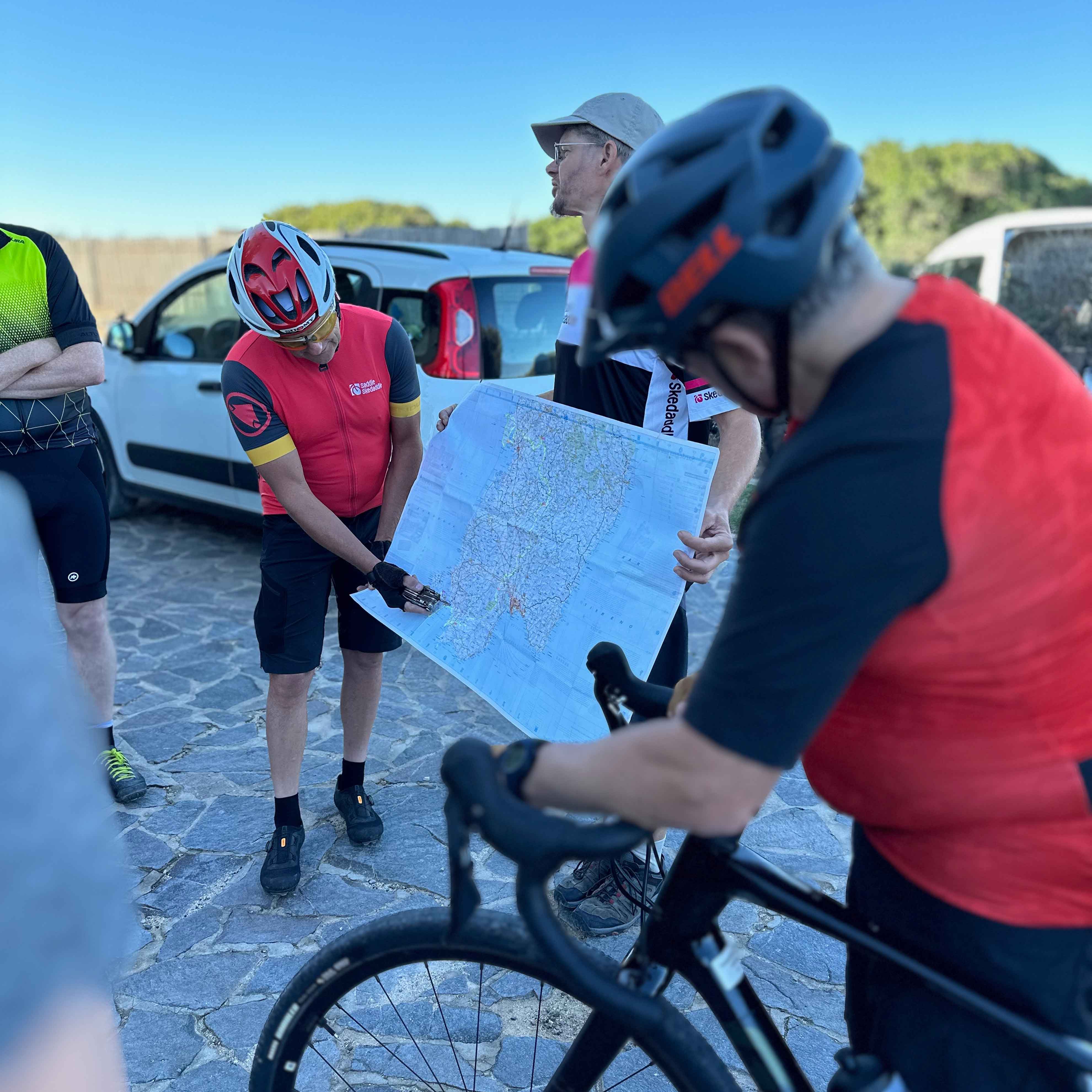
Each day had a generally consistent pattern. Breakfast was served from 7 am most mornings and we had to be ready to roll out at 9am on the dot, with bags packed and deposited close to our support vehicle, bar bills paid and room keys handed back in. We were ably looked after on the tour by two Skedaddle cycling guides, Lieven, a Belgian who had lived on the island for nearly 15 years and who had planned the route, and Mirko, an Italian who lived in Turin, but had worked extensively on Sardinia as a cycling guide and had the co-led (with Lieven) the inaugural running of the trip in the spring of 2024. Our morning routine included a detailed briefing about what to expect, a quick check over of the bikes, topping up of water bottles and jersey pockets (with snacks) and then we were off.
The first section of Day One was the perfect introduction. Sun-baked vehicle width tracks. Tantalising glimpses of the Sea of Sardinia off to our right. Sections of minor roads, generally free of traffic. A brief spin onto a deserted beach. You could feel the collective buzz as we stretched our legs under an azure sky.
"The view from the top was as stunning as Mirko had promised."
The first obstacle therefore came as somewhat of a shock. On the map, the climb above the beach at Cala Lunga looked like a perfect opportunity for an early morning photo stop. However, as we got to the base of the climb, Mirko, who was guiding the first day (whilst Lieven drove the support vehicle), sprinted off to check on the condition of the climb after some heavy storms earlier in the summer. He returned to give us the bad news that the trail was badly eroded and he advised we got off and walked up. If you had arrived at the foot of this climb on an XC MTB or as a seasoned gravel rider with many days of Alpine riding in your metaphorical log book, it would have been a relatively simple task, but to a group of mixed ability cyclists, some of whom were pretty new to gravel riding, this trail looked a little off-putting. Fortunately, it was short and the view from the top was as stunning as Mirko had promised.

From the top of the climb, our day of incredible variety started as it meant to go on. We swooped down flowy, rock-strewn descents, we tackled short steep climbs, where the trail surface was made of decomposing granite. We followed singletrack trails through low, scrubby bushes. We rode (generally successfully) around the occasional puddle. It seemed like every few minutes there was another incredible view, or a change of trail surface or, frequently, both at once.
"It was day of ying and yang. For every loose, scrabbly climb, there was a swoopy, flowy descent."
It was day of ying and yang. For every loose, scrabbly climb, there was a swoopy, flowy descent. A short, steep climb which put heart rates through the roof resulted in stunning views. We rode on minor paved roads, poured concrete tracks, an access road made astonishingly of beautifully hewn local stone laid so carefully you would have thought it was a cocktail terrace at a grand mansion rather
The real star of the day though was the proximity of the sea. At points we were high above it, the sun glistening of the turquoise water like a mirror, but as we got closer to our destiny with a picnic lunch, we descended to the point we could smell the saltiness and feel a (slightly) cooling breeze.
Part of Lieven’s job when working on the route for the trip was to try and create one which encapsulated everything that was great about Sardinian gravel riding in just six days of riding. The issue he had of course was that everyone’s view of what is gravel riding varied dramatically depending on their background, experience and fitness level. Sections of sand, loose gravel, steep climbs, rocky descents – these are all manner to heaven for an experience rider, but for someone else they could represent their idea of hell. The temperature and the scarcity of water – the one downside with coming at the end of the season was that many of the normal cafes were closed – ramped up the difficulty somewhat further.
Everyone except me had opted to use Skedaddle’s own hire fleet. These were an impressive sight – high end, full carbon Giant Revolts, fitted with Shimano’s latest GRX 2x12 groupsets, the bikes were way above the level you might have expected to be provided. Interestingly though, despite the fact that the 2x set-up offered a much greater range of gears and smaller steps between each gear, the front derailleur (or at least, lack of experience in using one) proved to be an issue for some of the customers. Luckily some tuition and some tweaking of the set-up seemed to fix most of this. Unfortunately, the tyres were a slightly harder issue to resolve, both literally and metaphorically. Although the bikes had clearance for up to 50mm tyres, most of them had been fitted with 40mm options. To avoid pinch punctures this necessitated the tyres being run at high pressures which meant less grip and more jolting, probably resulting in greater levels of fatigue at the end of the first day. From Day Two onwards, Lieven and Mirko lowered the tyre pressures and this seemed to help.
The other thing that Skedaddle do to help reduce fatigue and keep energy levels up is to provide an incredible re-supply service. At regular stops through each ride, whichever of the guides was on driving duty that day would find a suitable shady/scenic/interesting/useful location and they would set up a support station for us. Whether you just wanted to refill your water bottle, required more snacks/fruit or needed a hit of sugar with pop/juice, they did an amazing job of looking after us. At lunchtimes this service went into overdrive with a full buffet picnic lunch prepared and laid out by the guides. We made regular use of local cafes too – a real benefit of bringing cycle-tourists to regions not visited by mass tourism is to help being in some financial impact for local businesses, but in places where there were no cafes or they had already shut for the season, the sight of the Skedaddle mother-ship parked up next to our route was a welcome one.
For many of the group, the highlight of Day One was undoubtedly the proximity to water. A long stretch before and after lunch was either directly beside the sea (the temptation to stop off and dive in was huge, given the hot temperatures) or through a vast network of salt lagoons, a haven to wildlife and a source of valuable income for Sardinia as the salt is sold to industry.
My personal (and very selfish) part was a section of sand that we had to traverse mid-way through the afternoon. Mirko had warned us about it advance and said we would probably have to get off and walk. This was like a red rag to a bull to me and I used my combination of big volume tyres, a bit of speed and some technique gleaned from many hours spent watching cyclocross racers trying to tackle this notoriously fickle master. Needless to say I didn’t manage to get across the whole section, but I gave it my best go!
As we got close to our hotel the sun had dropped just low enough in the sky for the colours to start to really pop and for some of the heat to fade. It was a very tired, but happy, group who arrived at our overnight hotel. Dinner that evening set a trend to be followed over subsequent nights – each hotel seemed determined to undo all the good work we had done during the day burning off calories and they were replaced in style with a delicious, multi-course dinner.
Day Two – Into the hills.
"This was climbing at its finest – the perfect gradient, stunning views and a mixture of sunshine and shade."
If Day One had been all about the sea, Day Two was all about the hills. The first day had been front-loaded with climbing (albeit all of them were short in length and low in height gain). The second day saw the climbing liberally spread through the day, but the first one came early on, before the temperature climbed too high. Initially on tarmac and then in the latter stages on a beautiful gravel road, this was climbing at its finest – the perfect gradient, stunning views and a mixture of sunshine and shade.
A fast flowy descent was followed by a longer climb, an amazing swoopy descent and a short, sharp, climb with the steepest section rudely located right at the end. By this time temperatures were into the low 30s C and there were some pained expressions and tired legs evident.
Just before lunch we rode through a nearly disserted village. There must have been something in the water in Barrancu Mannu because it had a very arty, alternative feel to it. As we rode into the village the first thing we spotted was a giant mural painted on the end of a building, then a small park completely full of brightly decorated plastic figures and then as we were leaving the village, we spotted a painter busily creating a second large mural. I stopped to chat and find out some more about the outdoor art. He told me that he lived in the village and hated how boring the concrete wall looked, so had decided to brighten it up. The mural had taken him eleven days to paint and the people featured in the painting were local residents. He seemed genuinely pleased that we had chosen to ride through his village and asked about what we doing and where we heading next. “Up” was my answer to where we were heading!
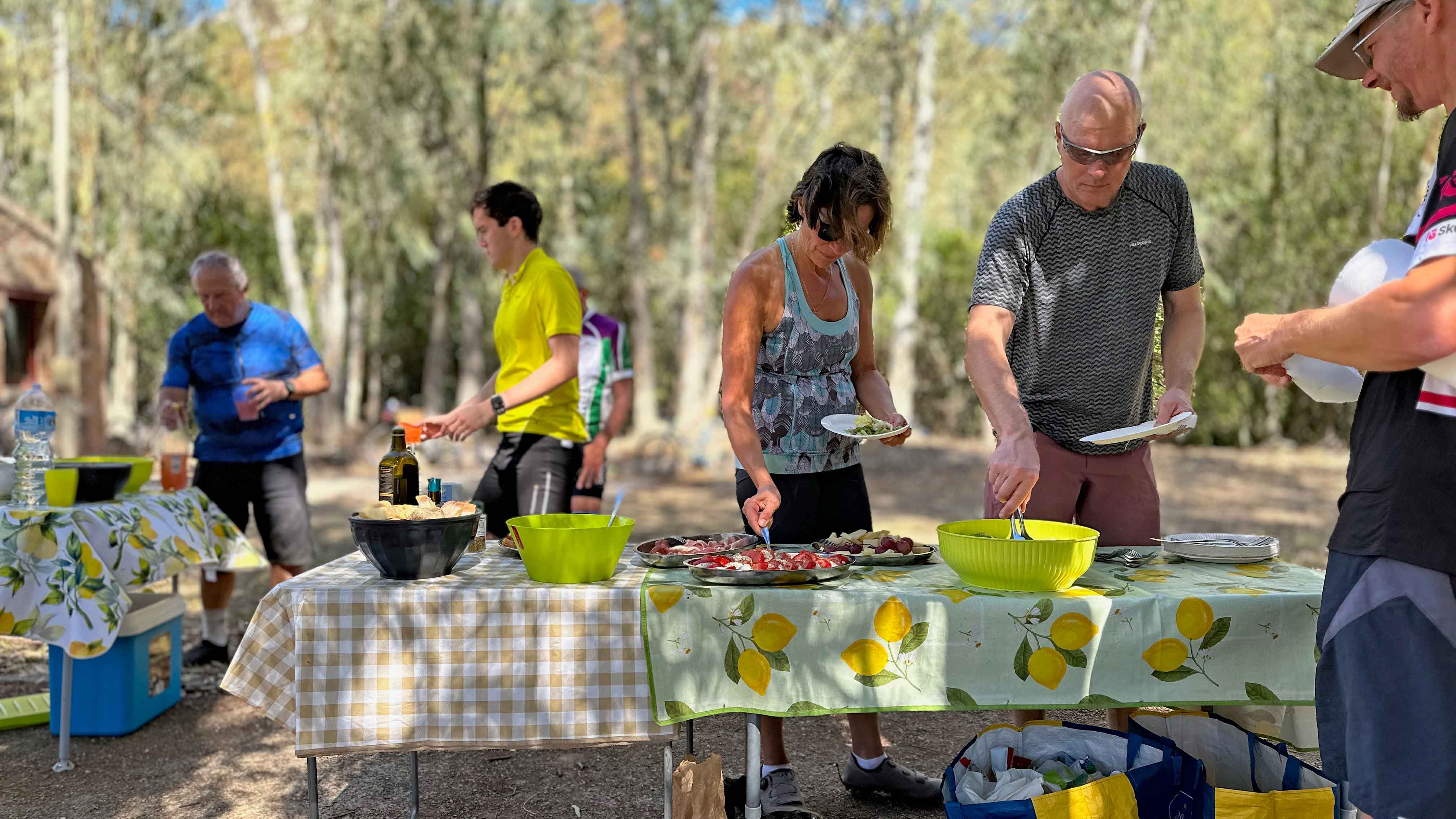
It was Lieven’s turn to be our chef for the day and he had created an amazing picnic lunch situated in a shady grove of trees on what used to be a marshalling yard for a former railway station. The shade and the food was welcome, but we knew that afternoon was our big challenge of the day – a 7 km gravel climb which would take us up the high point of the day. The height gain was only 300 m, which in the scheme is things is nothing, but the combination of full bellies, hot sun and a gravel surface which bounced back the heat meant the climb felt harder than it should have done. Fortunately, the views were great and there were patches of shade in places.
" You had to choose to ride through, swerve around or try and bunny hop over them."
Having successfully made it to the high point, we had a destination with gravity – nearly 20 km of gravel road descent was next on our agenda. The gravel road snaked its way down the mountain and we kicked up a dust trail in our wake. The surface of the track, which Lieven assured us had been smooth earlier in the year, was somewhat pockmarked when we took it on and it certainly required a good amount of concentration. The holes weren’t all that big, but there was a lot of them and for each one you had to choose to ride through, swerve around or try and bunny hop over them, each technique having its merits but also exacted a toll on energy and concentration levels.
The final section of the route, which took us straight to the next hotel was a series of undulating vehicle width gravel trails. The network was incredible, with only tiny sections of linking tarmac required to take us from one trail to the next. My bike computer registered just over 70 km and 1200m of climbing for the day – nothing to set ultra-endurance gravel athletes hearts fluttering, but plenty enough for most of the group. After a day of bone dry, dusty conditions, the bikes were given a quick wash and brush up by Mirko & Lieven – proving the misquoted old adage that a guide’s work is never done.
Day Three – Crossing the Campidano Plain
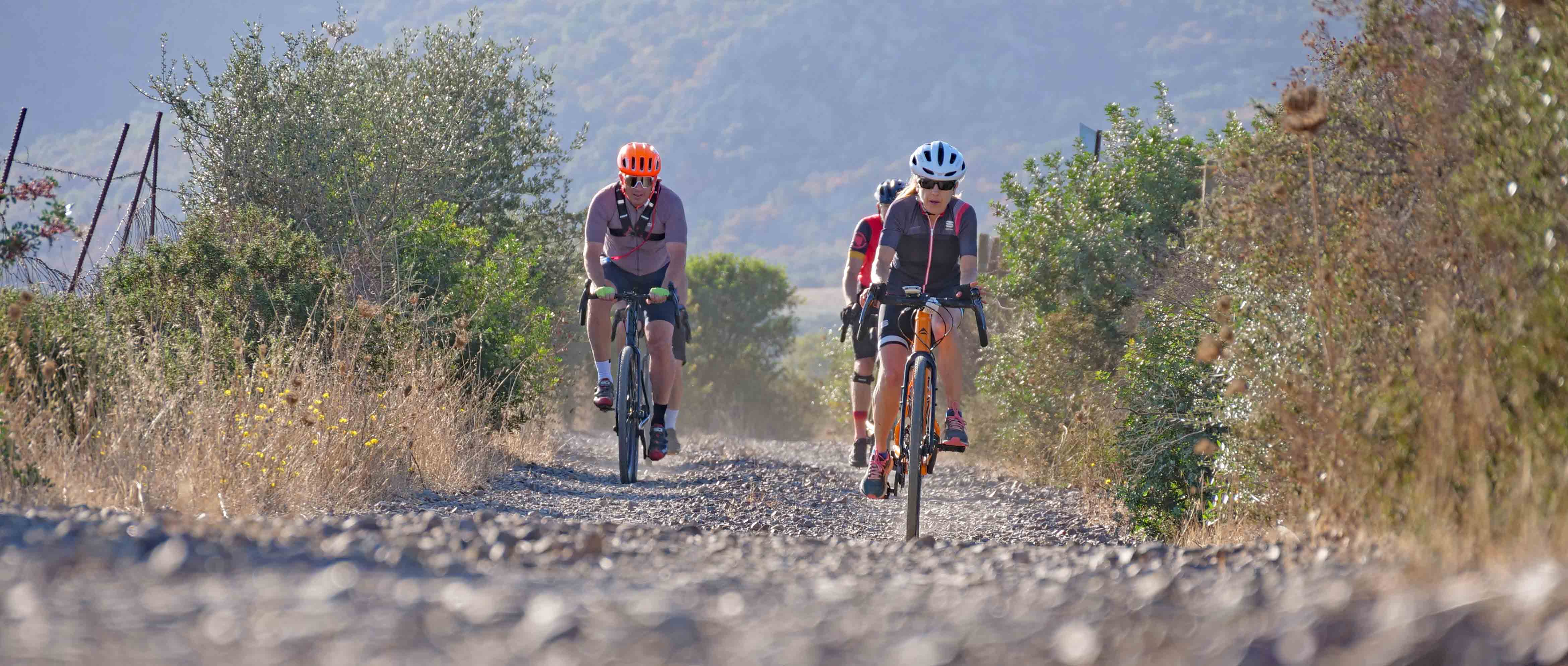
After a day spent riding primarily in the hills, Day Three was scheduled to be quite different – quite a lot longer and much flatter too. We would be riding across the Campidano Plains, a geographic phenomena where a depressed layer of the earth’s crust bounded by fault lines lies buried under nearly 600m of sedimentary deposits, the plains are pan flat and incredibly fertile. We started as we meant to go on with a super-fast and flowy gravel track, dust clouds kicked up in the early morning light. Initially we had mountains directly in front of us, but they soon faded into the distance as we headed into the plains proper.
After the arid and seemingly infertile land of Day Two had been replaced by the opposite on Day Three. Everywhere we looked were fields full to bursting with greenery – artichokes particularly seemed to be the crop de jour and the fields were full of workers, backs bent, as they hand-picked the best of the harvest.
The amazing variety of riding from Day Two was continued into Day Three. Vehicle width trails between long lines of eucalyptus trees, stretches of minor road, little squiggles of singletrack across agricultural land, sections of hard-packed sand, concrete roads around small, long-abandoned industrial developments all formed part of the mix. Perhaps the most unusual section was around a NATO airbase. We happened to time our visit with a jet fighter pilot practicing their bumps & circuits and at one point our route took us right past the end of the runway, something which created some TopGun-esque excitement amongst the men and some looks of incomprehension among the women. Our next destination was Lieven’s home village, San Sperate, home to some incredible street art, murals and an open-air museum, not to mention an excellent coffee stop in the centre of the village.
Lieven was back on ride guide duty for Day Three and he regularly used his knowledge from being a PhD qualified Archaeologist to teach the group about the incredible history we were riding through. Neolithic burial grounds and Roman quarries, complete with visible chisel marks to show where the stone had been hewn from the surrounding bedrock and deeply incised tracks from the passing of Roman chariots, were just two of the attractions located close to our chosen picnic lunch spot.
" The smoke from frequent stubble burning fires drifting across our path often creating a slightly dystopian feel."
The afternoon featured numerous sections of the Sardinia equivalent of Strada Bianche – fast, smooth gravel roads across the plains, the smoke from frequent stubble burning fires drifting across our path often creating a slightly dystopian feel. The downside of the plains was the arrival of a not-insignificant headwind and there were some tired legs evident as the afternoon wore on.
“What a f*cking delightful climb” said Idris, who until this point had been incredible genteel and civilised
“What a f*cking delightful climb” said Idris, who until this point had been incredible genteel and civilised. It was one of those moments that you couldn’t have scripted and it generated peals of laughter, some of which were tinged with relief at having made it to the top of the penultimate climb of the day. The trail had started off smooth and with only a gentle gradient, but after a 90-degree left hand turn, the gradient and the surface had spiked dramatically. Fortunately relatively short, the gradient ramped up exactly as the surface deteriorated to a loose, rubble. There was a smooth line, but you had to hunt for it and for the less experienced in the group, the combination of gradient, surface and hot mid-afternoon temperatures, the challenge was a decent one!
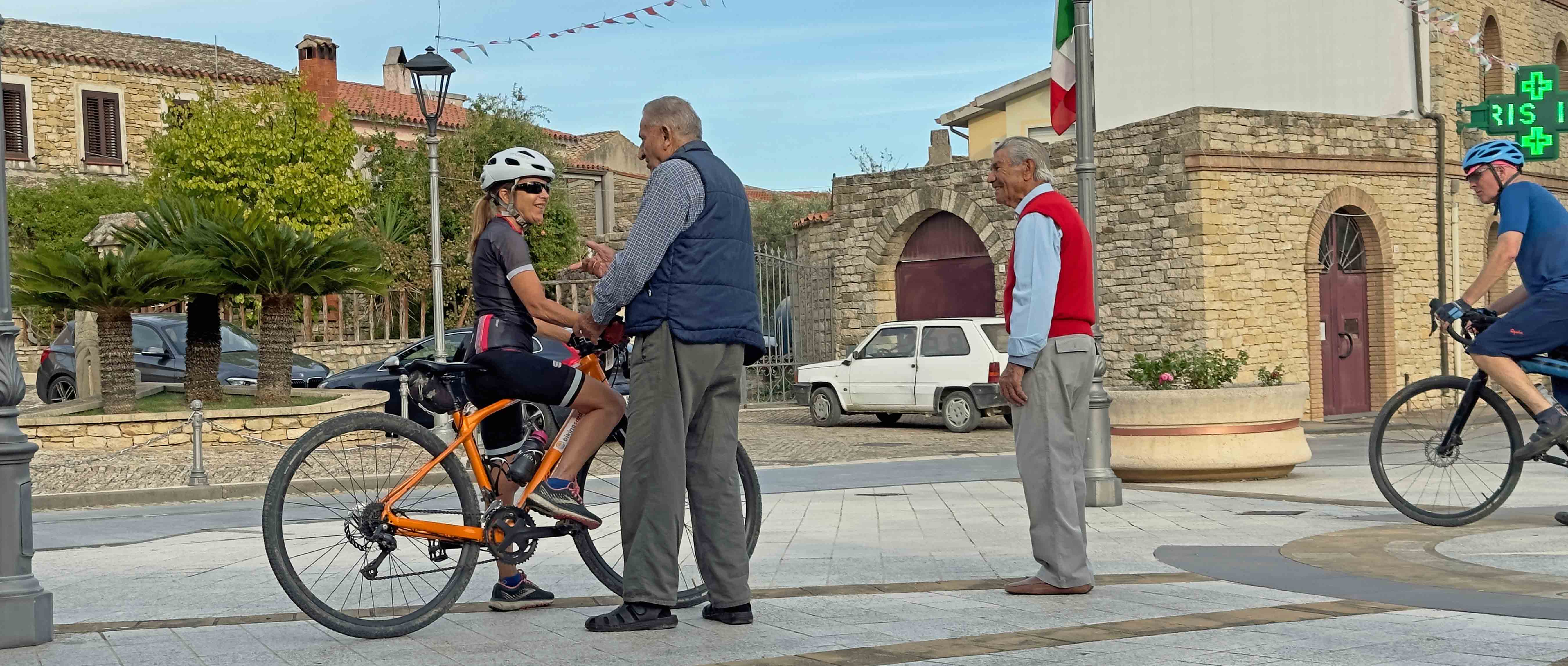
“We’re so happy that you’ve come to visit our village. We never get tourists here. We’re both 90 years old by the way.” The greeting we received from two extremely spritely nonagenarian residents of Villanovafranca was incredible and heart-warming. The two chaps practically sprinted across the village square to shake everyone’s hand and to try and engage us all in conversation. My very rusty Italian skills were put into action to help translate some of the amazing warmth of their greeting to the different members of the group that they were chatting with. It was without a doubt a highlight of the day and one of the most memorable experiences of the entire trip. It captured everything that’s brilliant about using a bike as a means of exploring somewhere – it helps break down barriers, will take you to places completely off the beaten track and allows you to interact with everyone that you meet along the way in a manner inconceivable to vehicle-bound tourists.
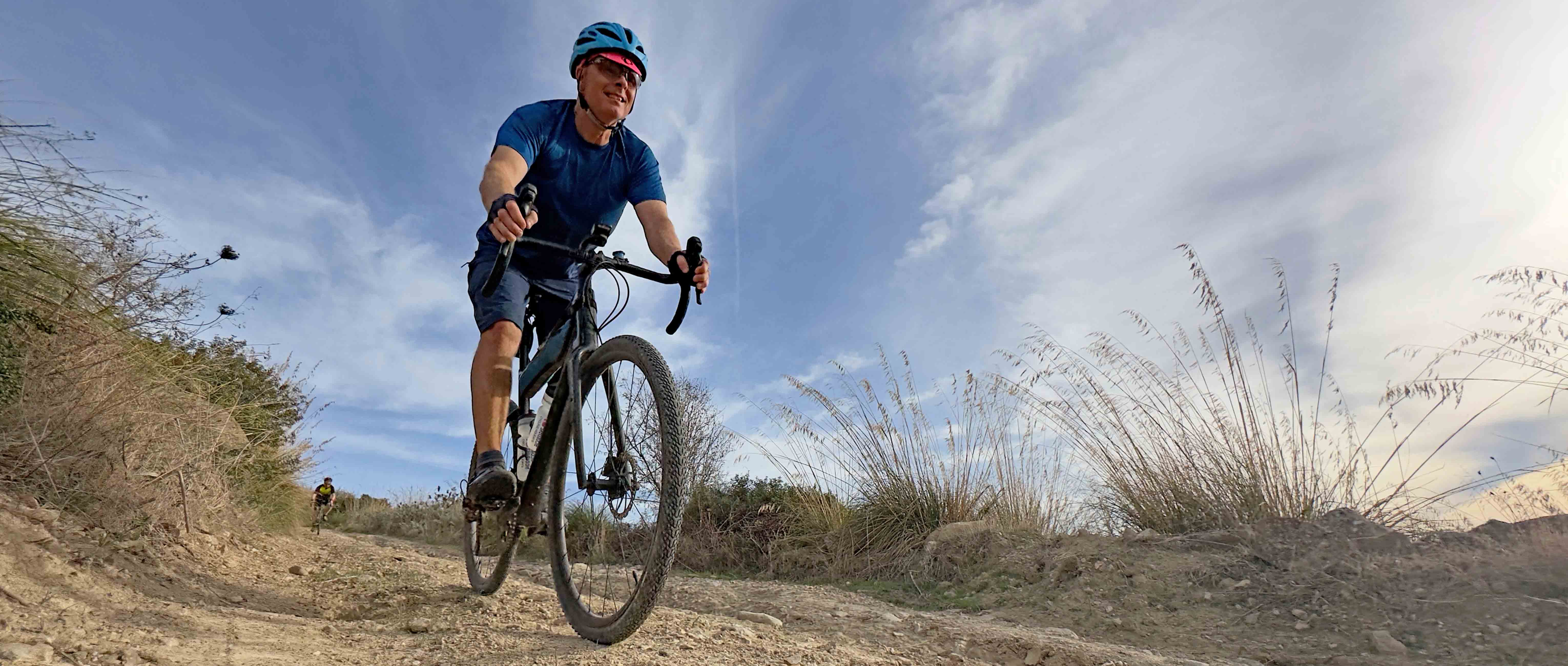
"The steep off-road descent down from the village was perfectly ridable but was probably a bigger challenge than some of the group had been expecting."
One of the reasons to book on a guided trip is that the local knowledge of the trails gives you insight that relying just on a GPX file couldn’t possibly match. Lieven and Mirko seemed to have near-photographic knowledge of trails and generally gave excellent descriptions of what was coming up next. After our coffee stop in Villanovafranca however the trail conditions were slightly more exciting than we had anticipated based on Lieven’s preview. The steep off-road descent down from the village was perfectly ridable but was probably a bigger challenge than some of the group had been expecting. There seemed to be a mix of big grins at the front of the group and slight consternation towards the back! Everyone made it down safely and it was only a short ride along an old railway line, converted into a perfect gravelly cycling path, to our next overnight accommodation, an agriturismo set in the hills just outside the village of Barumini. An incredibly warm welcome from the hostess and some amazing home cooking soon restored tired legs and jaded bodies.
Day Four – The rain (in Sardinia) falls mainly on the plain.
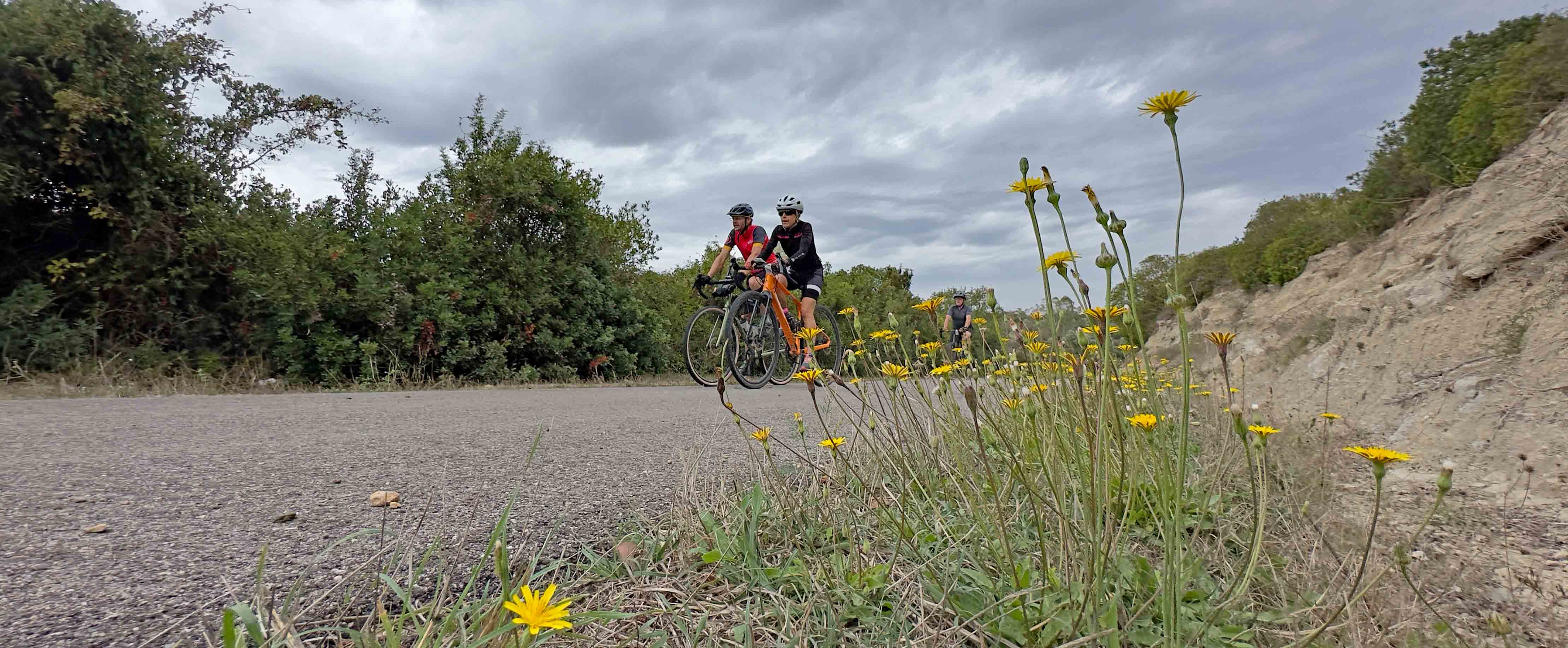
"Waking up on Day Four to scudding clouds, flat light and lower temperatures was a bit of a shock."
Having had unbroken sunshine since our arrival, waking up on Day Four to scudding clouds, flat light and lower temperatures was a bit of a shock. It was still a pleasant temperature for riding but felt more autumnal than we had been used to. The forecast for the day predicted heavy rain to arrive early afternoon, so everyone kept a rain jacket to hand just in case and the guides came up with a Plan B and a Plan C in case the weather arrived early and messed up their plans for a picnic lunch. They also made the decision to use the “wet weather” variant of the route – this cut out a planned off-road climb which would have taken the group over a high plateaux which can be badly affected by poor weather and also increased the proportion of minor roads (instead of gravel tracks) included in the overall route.
The route for the day started off perfectly with a long gentle warm-up on a former railway line, now converted into a shared use trail. A couple of unlit tunnels kept the interest levels up – it was surprising how discombobulating it was to ride in the darkness and everyone seemed quite relieved to arrive safely into the daylight at the far end. After a non-challenging start to the day, Leiven’s route next took us on a couple of more entertaining trails – flowing topography, ancient tracks bounded by dry-stone walls and increased levels of vegetation enmeshing the trail all kept us on our toes and made the ride up to our first coffee stop a little more challenging.
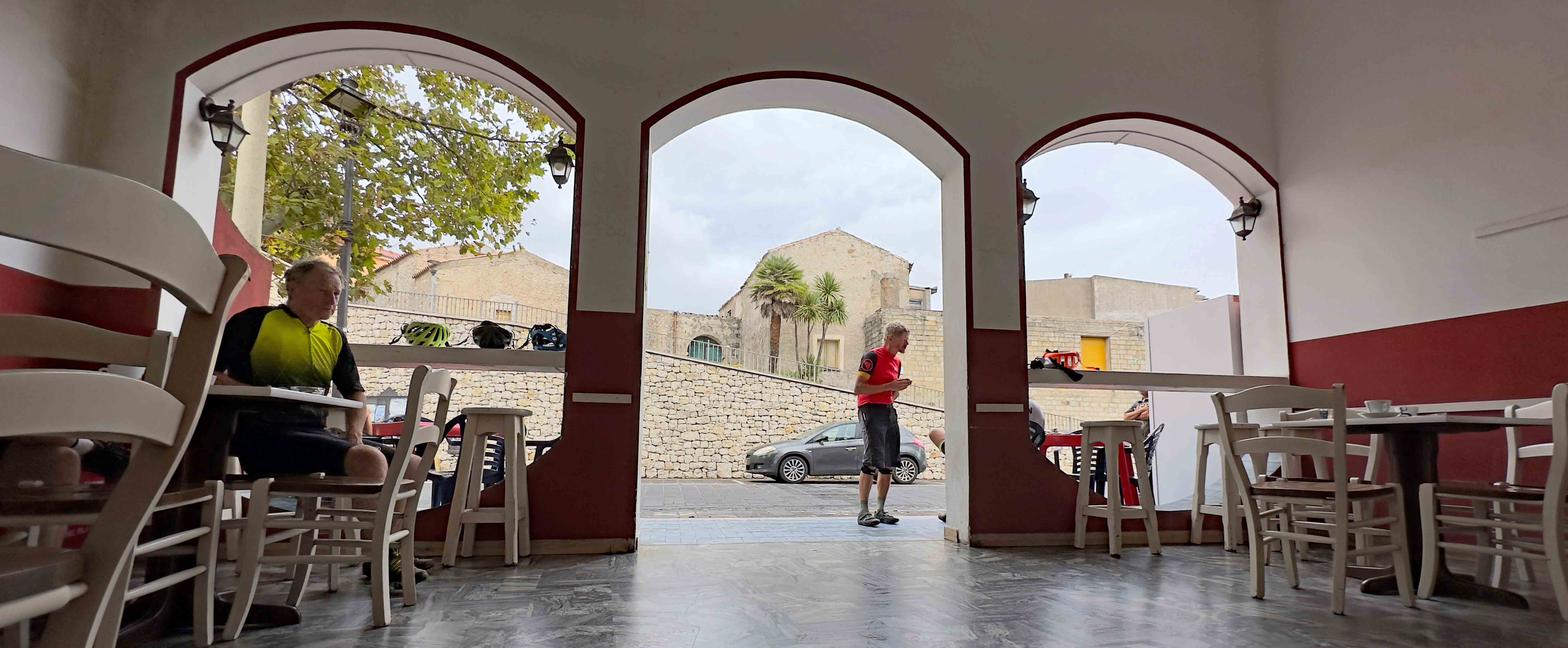
It felt unlikely that the hilltop village of Genoni had ever really been on the tourist trail, but the welcome we received was as warm as elsewhere. Initially some of the local residents, a few of whom were drinking mid-morning caffé correttos or even glasses of beer, looked at us slightly strangely, but this soon turned to greetings and attempted conversation. Clad in an interesting mix of ex-army camouflage and sportswear, the locals seemed as eclectic and interesting to us as we obviously were to them. We were asked multiple times where we had come from, what we were doing in Sardinia, what our destination was for the day. The bar manager was delighted to both have had a boost to her income for the day and also to have been given the chance to practice her English.
After we left the café it was a short ride on tarmac to the location of our early lunch. Mirko had negotiated with a café owner to let us use their terrace for a mixed lunch of hot panini and drinks provided by the café and salad/snacks provided by Mirko. As we arrived, dark foreboding skies were building and it seemed as though Mirko’s plan to have lunch in a sheltered location was going to be a good one.
"Huge gobs of water cascaded out of the sky and bounced off the tarmac."
The first rain drops started falling within a few minutes of us finishing lunch and by the time we were ready to ride, a steady rain was falling from the sky. With wet weather gear donned, we continued on our way. Fortunately despite the rain, which got heavier by the second, the air temperature stayed around 20 degrees, so although we were soon absolutely drenched, at least we didn’t get too cold. The intensity of the rain increased to the point where it was like something from a Hollywood movie – huge gobs of water cascaded out of the sky and bounced off the tarmac, hampering vision, reducing braking to a cacophony of squeals and generating a slightly resigned air to the group atmosphere.
At a suitably sheltered re-grouping point, Lieven announced that he was going to alter the afternoon’s route, increasing the proportion of tarmac and removing one particularly difficult off-road descent. With the rain continuing to bounce off the floor, this seemed like a wise decision. Fortunately, as the ride progressed, the conditions ameliorated and by the time we arrived at our mid-afternoon coffee stop, the rain had stopped altogether. A very be-draggled looking group took over the café and much to the amusement of the bar manager, ordered vast quantities of hot drinks. A couple of locals called in for their mid-afternoon caffeine hit and then stayed, chatting with us, for quite a while, absolutely amazed at what we were doing (and probably the fact that we were in ‘their’ café at all).
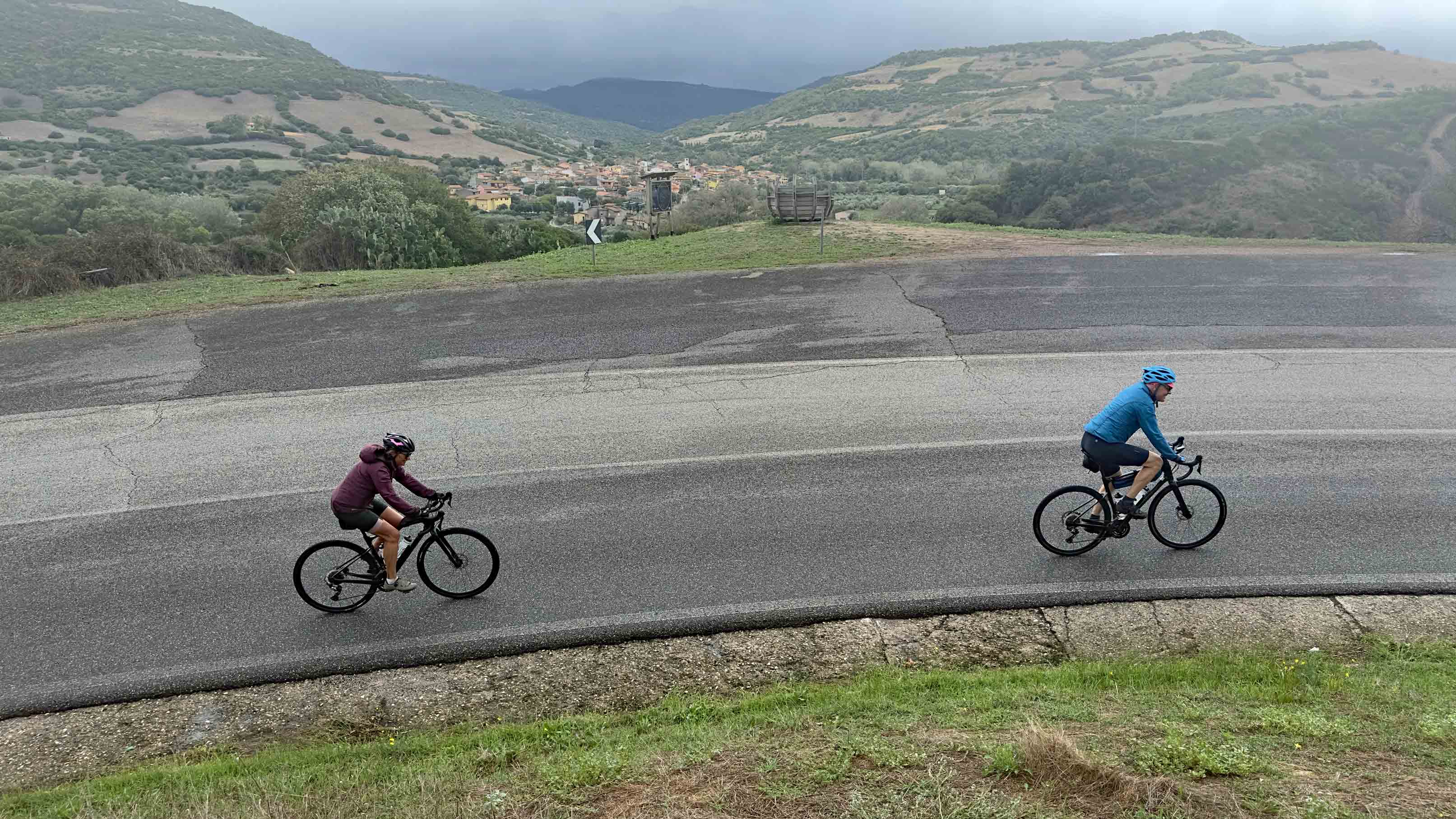
Although we all spent a little while shivering in the combination of lower temperatures and damp clothes as we left the bar, the subsequent hill climb soon returned core temperatures to normal and by the time we arrived at the very luxurious overnight accommodation, a 4* rated thermal spa hotel located just above the Roman spa town of Fordongianus, everyone had dried out. A mid-afternoon arrival allowed us to make the most of the spa facilities available, not to mention to catch up on the trip ‘admin’ (washing clothes, sorting out kit and catching up on sleep) that a multi-day point-to-point trip tends to entail.
Day Five – Learning the Italian word ‘spina’
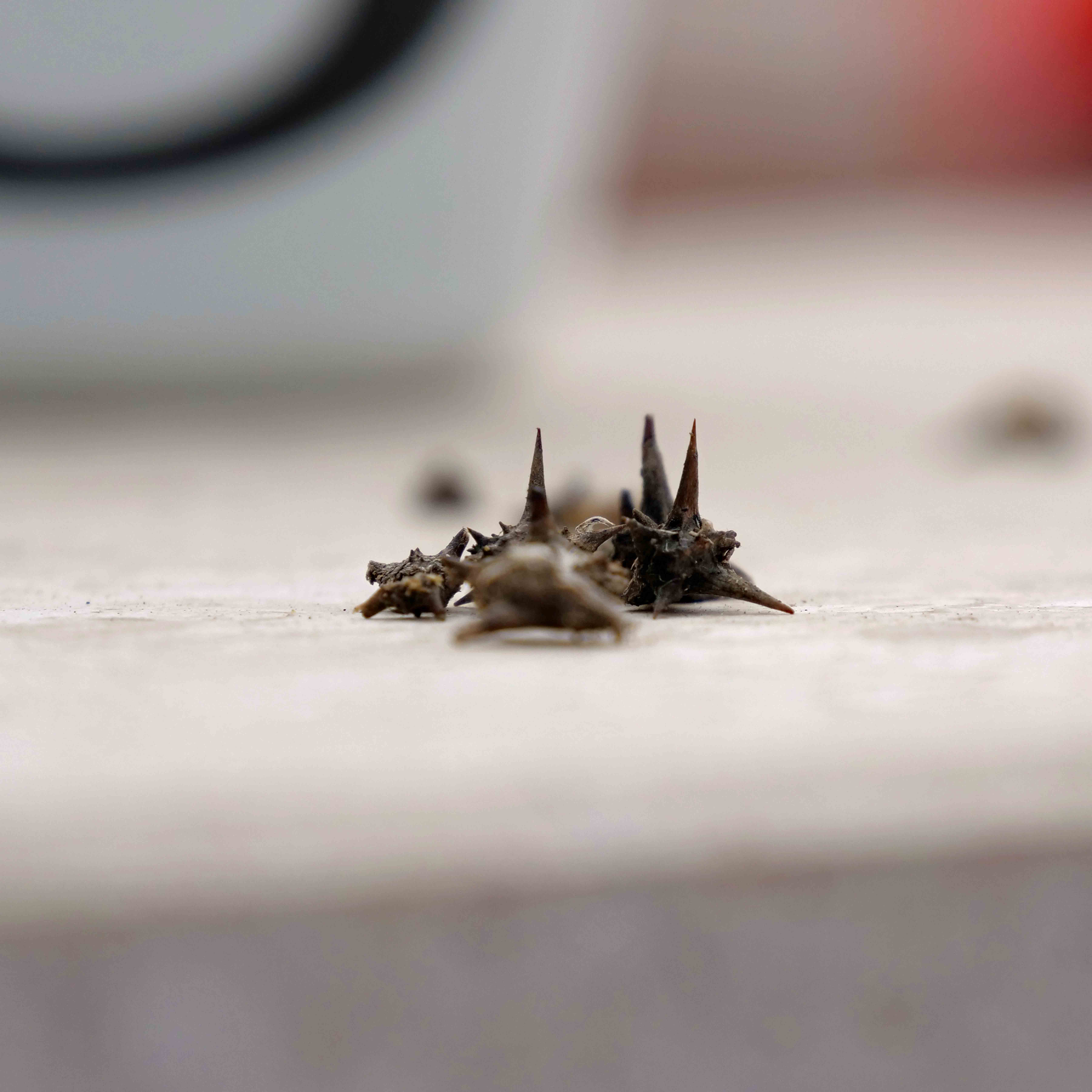
The profile of Day Five’s ride was hilarious – a climb right from the starting gun, followed by 12 km of descending and then pan flat for the next 50 km to the overnight stop, located near the coast. The day dawned overcast, but with brighter skies and warmer temperatures. The forecast was for the weather to improve as we got further west, but for there to be quite strong headwinds at times.
You can’t stay close to a former Roman spa bath and not call in for a visit, so that was our first destination for the day. The naturally heated water is used by the hotel where we had stayed, but can also be accessed at the former Roman spa and in the adjacent river. A number of camper-van based tourists had spent the next to the natural hot spring and were starting their day with a hot dip as we rolled up to test the water!

Our only topographical challenge for the day was a 6 km climb up to the high point at a whopping 250m above sea level. Initially on tarmac, the route soon turned off onto a pristine gravel track which wound its way scenically up to the high point. With autumnal colours just starting to be visible and perfect conditions under wheel, it was a very contented group who regrouped at the summit, before a fast off-road descent, rocky in places, which took us on towards the coast. After the initial off-road section, we joined a velvety smooth paved road and descended at speed to the valley bottom. Our route for the rest of the day was sections of amazing gravel road, linked up with short sections of tarmac. The route for the day was more than 70% off-road and although none of it was gnarly, it proved to still be a good challenge.
" Within the space of a few minutes all of the bikes fitted with tubes had suffered the same fate."
The first puncture was announced by one of the clients before we had even left the mid-morning water & snack spot. Less than a minute later, I noticed my front tyre was oozing tubeless sealant too. Lieven had already asked us to stop at a small café in the nearby village and as we sat there in the sunshine he sent a WhatsApp message to the group to say that he had pulled five thorns out of the first punctured wheel and he asked everyone to check their own bikes as he figured more people would have picked them up too. Sure enough, within the space of a few minutes all of the bikes fitted with tubes had suffered the same fate. The thorns were Tribulus terrestris, an invasive species known to have spiney burs (known as ‘spina’ in Italian). The hire bikes were fitted with a mix of tubeless and tubed-equipped tyres and it soon became apparent that all the bikes fitted with tubes had suffered the same fate. The sheer number of the spiny burs meant that even some of the bikes which had been set-up tubeless had not escaped unscathed and they needed wheels rotating to better distribute their sealant and air pressures subsequently topped up.
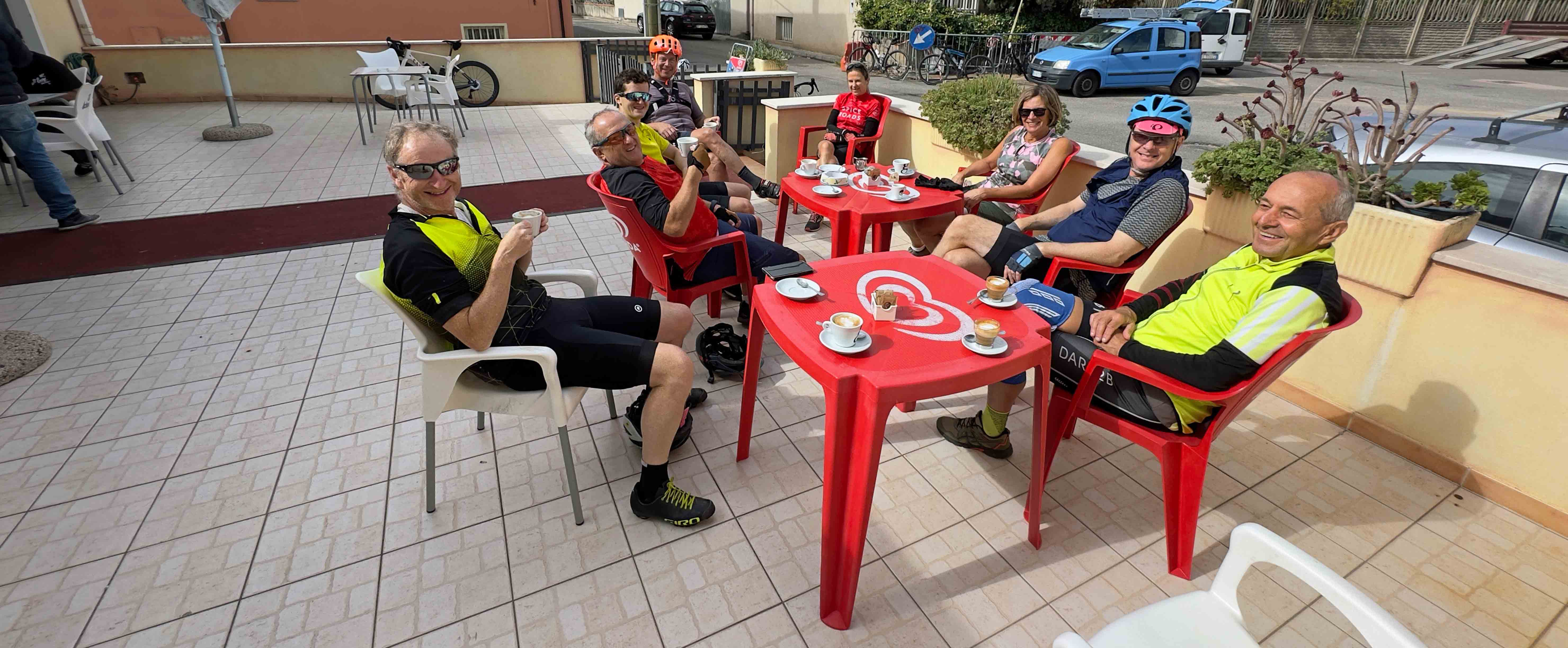
All the bikes fitted with tubes had to have them changed, but actually finding all the thorns which had penetrated the tyre casing proved to be a laborious task. Mirko & Lieven spent ages carefully checking the inside of each tyre and still some of the thorns escaped unnoticed, only to re-appear later in the afternoon as an unwanted souvenir from our snack stop. Fortunately, the timing of the puncture fest had been perfect and the group were able to sit in the sunshine drinking coffee while the bikes were repaired and made ready for the road again.
The trails after the puncture fest were amazing – super smooth, fast and with just enough variation to keep everyone entertained. The headwind proved to be a strong adversary in places though and it was a surprisingly tired group who arrived at the scenic lunch stop a little later.
"With hot sunshine beaming from an azure sky again, a few of the group took the opportunity for an impromptu siesta after lunch."
Lieven was on cheffing duty on Day Five and came up with another incredible picnic. Fortunately for him and Mirko, this was the last one scheduled for the trip, as the amount of effort they go in creating them is impressive (and very well received by the group). With hot sunshine beaming from an azure sky again, a few of the group took the opportunity for an impromptu siesta after lunch, but the delay caused by the puncture fests meant we were quite a long way behind schedule, so their repose was cut short as we needed to push on in order to make our schedule for dinner at the overnight hotel.
"The flat terrain, numerous junctions and strong, gusty winds made things difficult for Mirko."
The trails in the afternoon were ideal – smooth and fast rolling with some fantastic views across the tidal lagoons and marshes that were found in the hinterlands on the way back to the coast. The flat terrain, numerous junctions and strong, gusty winds made things difficult for Mirko though and reminded me exactly why I took the decision a few years ago to no longer guide cycling groups. With post-lunch lethargy affecting some of the group, while other members had been re-energised, there was an immediate split and Mirko had to somehow slow the ones down at the front and hustle along the ones at the back. He was in a difficult situation and there were a few slightly grumpy comments at the next re-grouping, which to his credit he dealt with professionally and smoothly.
As we neared the hotel a couple of the hire bikes started to lose air pressure in their tyres again, so Mirko took the decision to change the final section of trail for tarmac and managed to shepherd everyone safely into the grounds of the final hotel.
Day Six – The magic roundabout
"The level of technicality ramped up as the day went on."
The final day’s ride bucked the trend of the others as it was a loop ride, meaning we had the luxury of being able to unpack for two nights and escape the mad rush to get our luggage ready before we set off. The route for ride took us completely around the circumference of the Sinis Peninsular and had a 70/30% split between off-road and road. Initially the trails were smooth and flowy, but the level of technicality ramped up as the day went on.
"Every so often, there would be little patches of golden light cast onto the landscape."
We started off on tarmac, but soon turned off road, a series of sandy farm tracks taking us to the village of San Salvatore, an incredible deserted village which is only inhabited a few days each year during a religious festival, used during the 1960s/70s as a set for Spaghetti Western movies. As a photographer, the morning of Day Six was my favourite – a strong breeze helped push the clouds across the sky and every so often, there would be little patches of golden light cast onto the landscape.
The terrain was perfect for the grazing of native Sardinian sheep at early on the ride we narrowly avoided causing an international ‘scene’ when one of the group accidentally diverted part of a flock of sheep which were being shepherded across the landscape. Fortunately my half-forgotten Italian had improved enough over the course of the trip to persuade the shepherd that we were contrite and that we hadn’t deliberately been trying to make his day more complicated than it already was!
"What was really brilliant to witness, was how the technical abilities of the group had improved so significantly over the course of the week."
After being lulled into a false sense of security by the gentle nature of the opening series of trails, it came as a bit of a shock when we arrived at the coast and suddenly had to concentrate again! What was really brilliant to witness, was how the technical abilities of the group had improved so significantly over the course of the week. A number of the riders said how happy they were that their skills had improved so much and how the technical challenges put them on the final day didn’t prove to be anything like as big an obstacle as they had on the first couple of the days of the trip.
The scenery and the trails along the coast were spectacular. The trails varied from smooth, heavily compacted sand to sandstone bedrock to ‘proper gravel’ and were entertaining and engaging. The views were suitably distracting though, so we made regular stops to take it all in.
Lunch on the final day was taken in a local fish restaurant, rather than as a picnic and this gave everyone to chance to try something different. Vast steaming plates of fried calamari, bowls of freshly caught mussles and enormous salads soon arrived. Despite some initial enthusiasm no-one had space for tiramisu afterwards though, despite the fridge being full of homemade samples of this archetypal Italian pudding.
Lieven had saved some of the best trails until last and we tackled some incredible sections of coastal singletrack. Fast hardpacked gravel was followed by twisty-turny, follow-the-leader trails through (and under) the typical coastal macchia vegetation (which smells as great as it looks) and all of it was ably assisted by a friendly tailwind – a welcome change after the headwind of the previous few days.
"With a combination of stubbornness, speed and big volume tyres, I just managed to get through the whole thing."
The piece-de-resistance (in my opinion anyway) was one final section of sand. Lieven dropped a very large gauntlet at my feet when he said he didn’t think it was rideable. With a combination of stubbornness, speed and big volume tyres, I just managed to get through the whole thing, but the obvious tyre imprint on the ‘crux’ corner shows how close I came to lying down face first in the sand!

With the final obstacle safely out of the way, all that remained was a gentle spin along the foreshore in the late afternoon sunshine and a well-earned glass of chilled prosecco to celebrate successfully completing the trip.
Over the course of six rides, 430 km and nearly 5000m of climbing, the group had successfully ridden Sardinia Cape to Cape. It wasn’t just about the stats though – in the course of the week we had experienced so many incredible views, interactions and encounters. Everyone went home as better riders, with more confidence in their abilities and hopefully an ever-greater love of gravel riding.
A huge thank you to Lieven and Mirko for their incredible guiding and care of the group and most importantly, thank you to Saddle Skedaddle for inviting me to join the trip in the beginning!
If you would like to find out more about Skedaddle’s Sardinia Cape to Cape gravel riding holiday, you should head over to their website.